What is Taking Refuge?
Divine Mother, Your chariot awaits!

~~OM~~
Photo of the week – Jan 5 – Jan 11, 2008
(Picture taken December 2007 at Devi Mandir, Napa, CA)
May Divine Mother always ride with us!
Temple of Divine Mother
~~OM~~
In 1987, while on one of their several tours throughout the United States visiting devotees, spiritual communities, and seekers; Shree Maa and Swami Satyananda met Robert Monroe at his institute in Virginia Beach.
Throughout the years, Mr. Monroe has written several books documenting his, originally, spontaneous out of body experiences. Over time he discovered a relatively simple process for inducing various levels of meditation and even out of body experiences in virtually anyone. He called this process Hemi-sync, and established an institute devoted to researching the ever increasing therapeutic uses of his discovery.
Briefly, Mr. Monroe discovered that by synchronizing brain waves of the two hemispheres of the brain, by means of playing separate pulses through earphones into each ear of a subject; one could be brought to ever deeper levels of meditation and finally to a full out of body experience.
This tape is a record of Swami Satyananda’s experience with Hemi-sync. And, it should be said that though Mr. Monroe has, over the years, guided hundreds of explorers to the farthest reaches of the Universe and to many levels of subtlety, the Swami’s experience was unique.
What Mr. Monroe heard was as follows. For devotees of the Mother Goddess, it speaks for itself.
Listen to Swami Satyananda at the Monroe Institute:
“I exist everywhere, in every time, in every object, in every form. But especially in those who know me in love and delight. Those who come to peace can come to love; those who are devoid of their own selves. Open your hearts and share with one another. Know that each and every form that you see is merely my reflection. Take joy in life. Be at peace. Be happy and share.. ” Download transcript: DOC
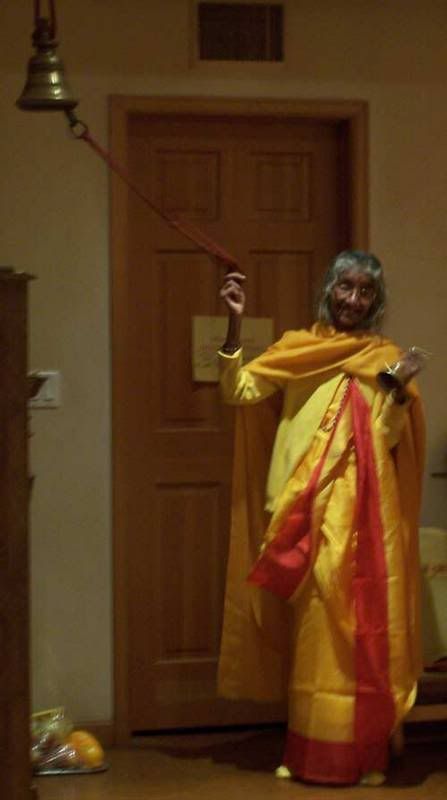
Photo of the week – Nov 30 – Dec 6, 2007
(Picture taken October 2007 at Devi Mandir, Napa, CA)
May Divine Mother ring the bells that purify our souls
~~OM~~
Ashwamedh means the use of wisdom for the benefit of society. It’s the horse sacrifice. The use of the wisdom of uccishrava, the horse of wisdom, which symbolized the dominion of the kingdom.
In the old Ashwamedha Yagya, a horse was set free, well adorned and decorated, followed by a great army. And wherever the horse roamed into the neighboring kingdoms, those kings would come out and they would either challenge and stop the horse which meant that they would do battle with the army; or they would accept the horse as an emblem of wisdom and they would surrender and unify the kingdoms into an empire.
And that way they reduced the amount of conflict in all the neighboring states by creating a unity in wisdom.
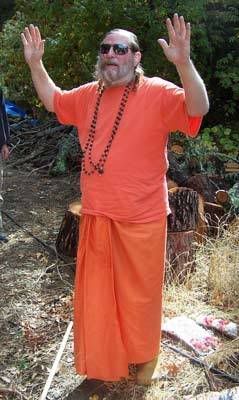
Photo of the week – Nov 9 – Nov 15, 2007
(Picture taken October 2007 at Devi Mandir, Napa, CA)
Take Diwali blessings to all.
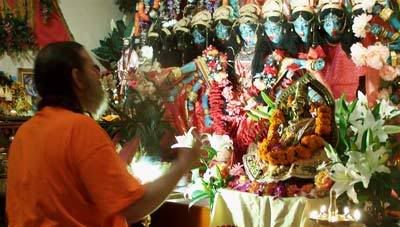
Photo of the week – Oct 26 – Nov 1 2007
(Picture taken Oct 20, Devi Mandir, Lakshmi Puja celebration)
Check out our new weekly blogs.
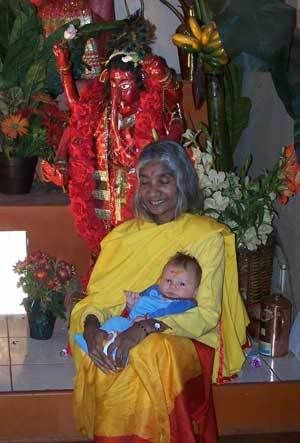
Photo of the week – Oct 5 – Oct 11 2007
(Picture taken Sep 2007 at the Devi Mandir)
Check out our new weekly blogs.
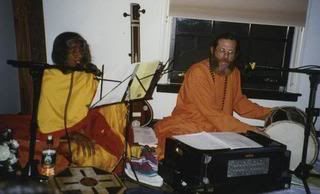
Photo of the week – Sep 28 – Oct 4 2007
(Picture taken sometime back during world tour)
~~OM~~
I want to tell you a story, if you don’t mind. There were three robbers, three thieves, who came upon a man in a lonely place in the forest. And the first thief said, “This guy is of no use for us, let’s kill him and take all his stuff.” And the second robber said, “There’s no need to kill him, lets just tie him up, bind him tightly, throw him in a ditch and take all his stuff.”
And that’s what they did. They threw him in the ditch, they tied him all up, they bound him, they stole all his goods and possessions and they made off.
The third thief walked down the path some way, and he started to feel very much remorseful. He started to think, “that poor guy is lying in a ditch all battered and bruised and bound, let me go back and help him.� And that’s what he did, he went to find the victim, and he attended to his wounds, and he unbound him. And he put him on his own horse and led him out of the forest towards his own village.
And the victim said to him, “You have been so kind to me, please come to my village and come to my house, and let me demonstrate my appreciation to you.” And the thief said to him, “I can’t go to your village.” “Why not?” “Well, the police are going to ask me why I was with the robbers in the first place.” And he disappeared. He ran away.
Now the first thief was tama guna. He says, “This guy is of no use for us, let’s just kill him.” The second thief was raja guna. He said, “No need to kill him, just tie him all up, bind him securely, throw him in the samsara, in the ocean of worldliness, where he will have all kinds of miseries.” The third thief was sattva. He says, “No, let me attend to your wounds, let me free you, let me show you the way to go home. But, I can’t go into your village. I can’t go to your house because I too am a thief.”
Sattva only shows the way to go home, he can’t go home with you. Sattva still binds you to the world in activity. To go into the house you have to be nirguna, without any quality. Not trying to do good, not trying to do evil, not trying to do anything. You become nirguna, and then you can go home.

Photo of the week – Sep 14 – Sep 20 2007
(Picture taken Aug 2007 at the Devi Mandir)